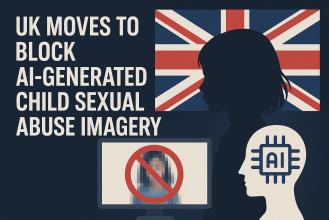UK Moves to Block AI‑Generated Child Sexual Abuse Imagery
- 15 November, 2025 / by Fosbite
Overview: What the New UK Law Means for AI and Child Safety
Key points:
- The UK will test AI models to confirm they block the generation of child sexual abuse material (CSAM).
- AI developers and platform operators can be held liable if tools fail safety checks.
- This change makes the UK one of the first countries to legislate model-level responsibility for AI‑generated sexual content involving minors.
The United Kingdom has amended the Crime and Policing Bill to target the growing problem of AI-generated child sexual abuse imagery. An approved testing team will put models through hands-on checks to see whether their safety measures genuinely stop users from creating sexually explicit images of minors. The angle here is straightforward: stop harmful content at the source, rather than play the endless game of catching it after it’s been published.
Why the UK is acting now
Regulators and NGOs have been sounding the alarm. The Internet Watch Foundation (IWF) reported a stark rise in detections — more than double year-on-year in recent months — and those numbers resonated across government and civil society. Between January and October 2025 the IWF identified and removed over 426 incidents; in the same period in 2024 it was 199. Those figures aren’t abstract — they’re the reason policymakers felt they needed a different approach.
What the law changes
- Model testing: A government-approved team of AI researchers and safety specialists will test models and judge whether safety features are sufficient to prevent generation of CSAM.
- Liability: The legal framework now extends liability to models and their operators if a system can be used to create illicit imagery. Practically, companies must show reasonable safeguards are in place and documented.
- Scope: The law targets both proprietary systems and widely deployed open-source models when they are put into service, limiting the ability of bad actors to bypass protections through prompt engineering or forks.
How testing and enforcement might work
We don’t yet have a public, itemised test protocol — details about selection, remit, and testing methods remain to be published. But reasonable expectations include red-team style attempts to bypass safeguards, reviews of training and filtering layers, and end-to-end assessments of deployed services. Think practical, adversarial testing rather than a paperwork-only audit.
In short: regulators want safety built in, not bolted on. As Technology Secretary Liz Kendall put it, tools should be made safe at the source while enforcement agencies continue to tackle publishing and distribution of illegal content.
Industry response and technical challenges
Major providers — OpenAI, Google, Meta — already run guardrails to block explicit generation. Yet the architecture of large multimodal and image-generation models makes absolute prevention hard: crafty prompts, model fine-tuning, or forks of open-source models can subvert protections. That’s the core tension here: prevention vs. the reality of determined bypass techniques.
The UK’s approach focuses on demonstrable, verifiable measures. Typical mitigations that are likely to be judged reasonable include:
- Pre-generation filters and content classifiers applied before image synthesis.
- Prompt-level detection and rejection layers that catch risky instructions.
- Monitoring and logging of suspicious use patterns to support incident response.
- Transparent red-teaming reports and clear remediation plans when failures occur.
Legal and ethical implications
This law shifts some burden away from post-hoc criminalisation (possession/distribution) and toward prevention at the model level. That’s sensible — but it isn’t simple. It raises practical questions: how do you balance safety with research freedom, what international standards will apply, and how do you avoid definitions so broad they stifle legitimate work?
- How will regulators balance safety with innovation and freedom of research? The truth is, there’s no perfect formula — trade-offs will be ongoing.
- What standards will be accepted internationally, and how will cross-border services comply? Expect friction and the need for mutual recognition or harmonised guidelines.
- How will the government avoid overbroad definitions that could stifle legitimate tools and research? Careful, transparent rule‑making and civil-society engagement will be key.
Practical example: a hypothetical test scenario
Imagine a startup launches an image-generation API. Under the new rules an approved testing team would run adversarial prompts, subtle manipulations, and chained instructions designed to elicit sexually explicit images of minors. If the model produces such images, or can be reliably coerced into doing so using known bypasses, the startup must fix the vulnerability — improve classifiers, tune rejection logic, or restrict access — or face enforcement. That’s not hypothetical for long; it’s the kind of real-world red‑team testing that exposes failure modes static audits miss.
Having covered AI safety for years, I can say: hands-on penetration tests are brutally effective at revealing what actually breaks in the wild. Immutable checklists rarely catch what a curious, motivated tester will.
International context and precedent
The UK is one of the first to tie model-level responsibility to CSAM prevention. Other jurisdictions are watching closely; this law could influence global standards on AI model accountability. If you want more background on how other stakeholders are tackling related issues, look at OpenAI's teen safety work and broader AI governance proposals from international bodies.
Further reading and sources:
- UK government announcement on tackling AI child abuse images
- Internet Watch Foundation (IWF)
- Times of AI coverage of UK AI policy
- OpenAI research and safety work
What this means for developers, companies and the public
For developers and platform operators: expect to document safety processes, invest in robust content filters, and prepare for red-team testing. Smaller teams that rely on open-source models will need to add guardrails or limit access if they want to avoid liability. Practical steps include logging decisions, keeping red-team reports, and having a clear incident response playbook.
For the public and advocates: prevention at the model level is welcome — but effectiveness depends on transparency, clear standards, and ongoing civil-society engagement. Ask the hard questions: will tests be public? Will red-team failures be disclosed? Who decides what ‘reasonable safeguards’ look like?
Takeaways
- Prevention at source: The UK seeks to make models themselves safer rather than rely solely on takedowns.
- Model accountability: Developers and operators will need to show demonstrable safety measures and testing evidence.
- Implementation matters: The law’s impact will hinge on the testing protocols, transparency, and international cooperation.
In short, the UK’s move signals a new phase in AI governance — treating model capabilities and deployment choices as matters of public safety. There are open questions, and the policy will evolve. Still, protecting children online demands technical safeguards and clear accountability; this law points toward that direction.
Note: this article references public announcements and reporting available from the UK government and independent watchdogs. For detailed legal or technical guidance consult the primary sources listed above.









